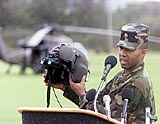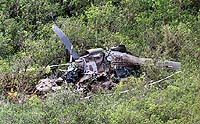 Soldiers' families, comrades grieve Soldiers' families, comrades grieve
By Scott Ishikawa
Advertiser Staff Writer
Two days after six Schofield Barracks soldiers were killed in one of Hawai‘i’s most deadly military training accidents, the Army said yesterday that the two Black Hawk helicopters that crashed were preparing to land but still could not confirm whether a mid-air collision took place.
 |
| Maj. Lawrence Madkins, operations officer for the 25th Infantry Division Aviation Brigade, displays aviator night-vision goggles of the type used by helicopter pilots Monday night.
Associated Press |
The Army said both helicopters were about 100 feet in the air when the 7:40 p.m. accident occurred at its Kahuku training area, about a mile mauka of the Kahuku Motocross Track.
Eleven soldiers were injured, and four of them were still hospitalized last night at Tripler Army Medical Center.
The two UH-60 Black Hawks were part of a group of four helicopters dropping off artillery, personnel and equipment from Schofield to support an air-assault training mission, said Army 25th Infantry Division public affairs officer Maj. Nancy Makowski. Eight other Black Hawk helicopters had successfully landed after the mission began at 7:30 p.m. There was light rain and an easterly wind of 15 knots at the time, she said.
The two Black Hawks were about 220 yards north of the landing site when they crashed, said Army Brig. Gen. William Caldwell, assistant division commander for operations and training. The other two helicopters were turned away after the crash, he said.
Caldwell said it is normal for helicopters to come in at a low altitude during an air assault — sometimes at treetop level — to avoid enemy fire and increase the element of surprise.
"At about 200 meters out, they were coming in low and starting to slow down," Caldwell said.
Caldwell could not say if weather was a factor, but said conditions were allowable for flying. The pilots were using night-vision goggles.
All 11 survivors were in a Black Hawk that landed hard but upright on a dirt access road leading to the designated landing zone. In that Black Hawk were seven soldiers from the division’s 2nd Brigade’s 1st Battalion, 27th Infantry Regiment; and four crew members of the 2nd Brigade’s 25th Aviation Regiment. It also carried a cargo net full of wooden crates carrying simulated ammunition.
"Helicopters are designed to absorb the impact of a hard landing," Makowski said. "As long as they remain upright, they can come down with great force and occupants will survive. They also have breakaway seats."
Caldwell said the first five soldiers taken out of it "were walking around and talking to us on the ground."
The Black Hawk carrying the six soldiers who died landed on the side of a gulch about 80 to 100 yards west of the other helicopter. On board were four crew members from the 2nd Battalion, 25th Aviation Regiment, and two members of the 2nd Battalion, 11th Field Artillery. It was carrying an Army Humvee vehicle in a sling underneath.
 |
| The wreckage of the Black Hawk helicopters that crashed, one of which is seen here, will be removed from the scene for further study, an Army general says.
Associated Press |
Makowski said military emergency officials were notified about the accident at 7:43 p.m. Three Army medevac helicopters already at the scene as part of the training mission responded. Other Army medical helicopters and city ambulances were also called to transport the injured to area hospitals.
Makowski said there was no fire after the accident, but fuel leaked from the wreckage.
Caldwell said the wreckage could be removed as early as Monday and taken to a hangar for further examination.
"There are still weapons on the ground," Caldwell said. Nothing was moved to keep the crash scene intact for investigators, he said.
The air assault mission was part of a two-week training exercise called Lightning Thrust Warrior. Caldwell said Army helicopters were allowed to fly again Tuesday afternoon, but no similar air assault training missions are scheduled for the remainder of the exercise, which ends tomorrow.
Officials from the U.S. Army Safety Center arrived Tuesday night from Fort Rucker, Ala., to lead the investigation. It could be three weeks before the investigation is complete.
"We are not going to speculate about things that the investigation will examine," Makowski said.
"The objective is not to assign blame, but to find the cause of the accident so we can share the lessons learned with other Army units and help them avoid the tragic loss that the 25th Infantry has suffered," she said.
A preliminary crash report will be given to top military officials while a more detailed final report is completed.
[back to top] |


